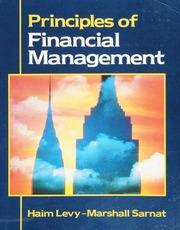Answered step by step
Verified Expert Solution
Question
1 Approved Answer
please help MODULE IV: TIME VALUE OF MONEY INTRODUCTION The time value of money analysis has many applications, ranging from setting up schedules for paying
please help 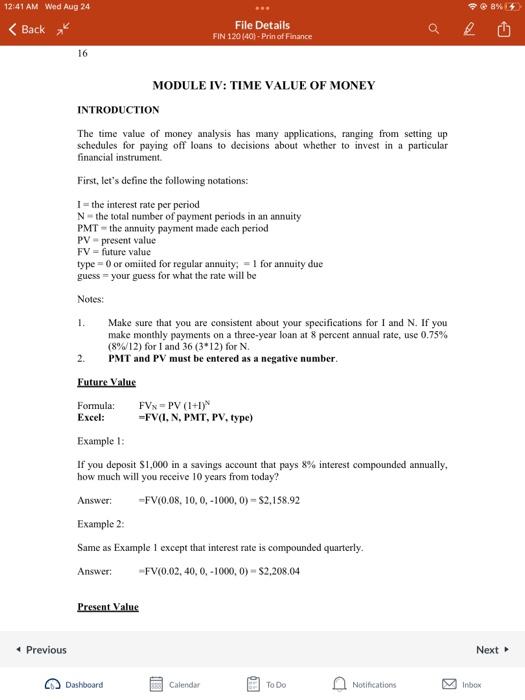
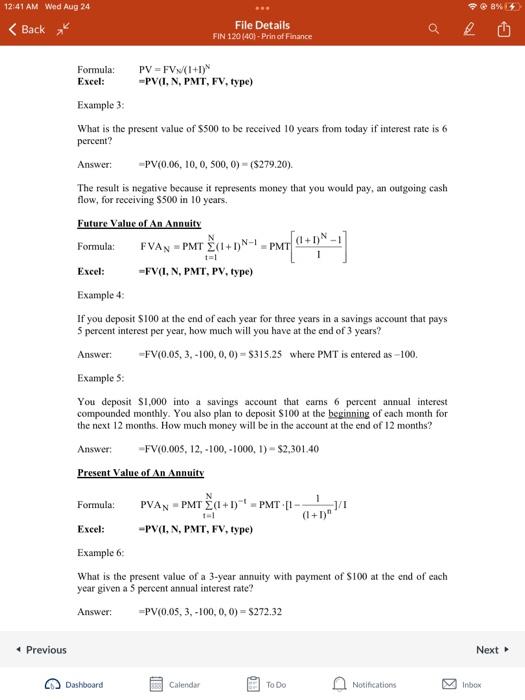
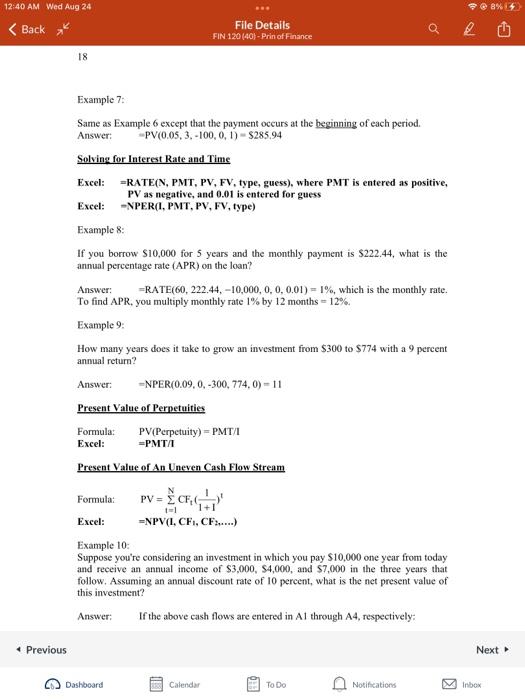
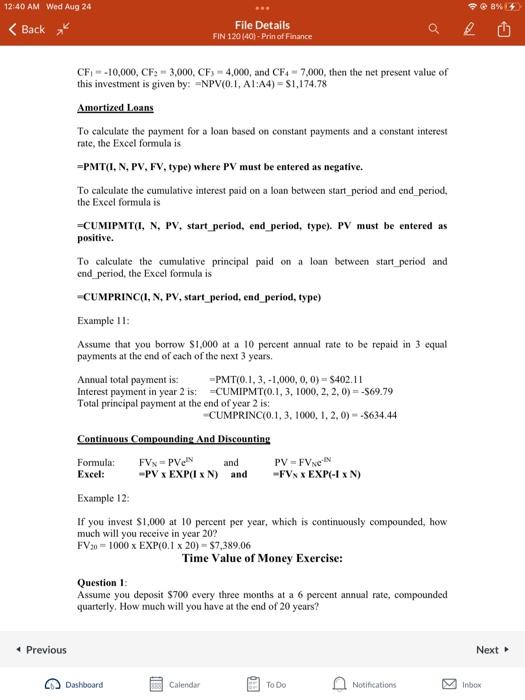
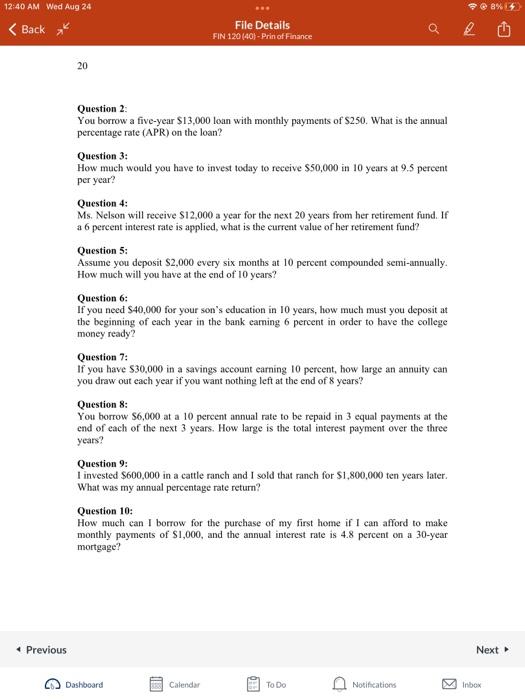
MODULE IV: TIME VALUE OF MONEY INTRODUCTION The time value of money analysis has many applications, ranging from setting up schedules for paying off loans to decisions about whether to invest in a particular financial instrument. First, let's define the following notations: I= the interest rate per period N= the total number of payment periods in an annuity PMT = the annuity payment made each period PV= present value FV= future value type =0 or omiited for regular annuity; =1 for annuity due guess = your guess for what the rate will be Notes: 1. Make sure that you are consistent about your specifications for 1 and N. If you make monthly payments on a three-year loan at 8 percent annual rate, use 0.75% (8%/2) for 1 and 36(312) for N. 2. PMT and PV must be entered as a negative number. Future Value Formula:Excel:FVN=PV(1+1)N=FV(I,N,PMT,PV,type) Example 1: If you deposit $1,000 in a savings account that pays 8% interest compounded annually, how much will you receive 10 years from today? Answer: FV(0.08,10,0,1000,0)=$2,158.92 Example 2: Same as Example 1 except that interest rate is compounded quarterly. Answer: =FV(0.02,40,0,1000,0)=$2,208.04 What is the present value of $500 to be received 10 years from today if interest rate is 6 percent? Answer: =PV(0.06,10,0,500,0)=($279.20). The result is negative because it represents money that you would pay, an outgoing cash flow, for receiving $500 in 10 years. Future Value of An Annuity Formula: FVAN=PMTt=1N(1+1)N1=PMT[1(1+1)N1] Excel: =FV(I,N,PMT,PV, type ) Example 4: If you deposit $100 at the end of each year for three years in a savings account that pays 5 percent interest per year, how much will you have at the end of 3 years? Answer: =FV(0.05,3,100,0,0)=$315.25 where PMT is entered as 100. Example 5: You deposit $1,000 into a savings account that earns 6 percent annual interest compounded monthly. You also plan to deposit \$100 at the beginning of each month for the next 12 months. How much money will be in the account at the end of 12 months? Answer: FV(0.005,12,100,1000,1)=$2,301.40 Present Value of An Annuity Formula: PVA N PMT t=1N(I+1)1=PMT[1(1+1)n1]/I Excel: PV(I,N,PMT,FV, type ) Example 6: What is the present value of a 3-year annuity with payment of $100 at the end of ench year given a 5 percent annual interest rate? Answer: =PV(0.05,3,100,0,0)=$272.32 Example 7: Same as Example 6 except that the payment occurs at the heginning of each period. Answer: =PV(0.05,3,100,0,1)=$285.94 Solving for Interest Rate and Time Excel: =RATE(N, PMT, PV, FV, type, guess), where PMT is entered as positive, PV as negative, and 0.01 is entered for guess Excel: =NPER(1, PMT, PV, FV, type) Example 8: If you borrow $10,000 for 5 years and the monthly payment is $222.44, what is the annual percentage rate (APR) on the loan'? Answer: =RATE(60,222.44,10,000,0,0,0.01)=1%, which is the monthly rate. To find APR, you multiply monthly rate 1% by 12 months =12%. Example 9: How many years does it take to grow an investment from $300 to $774 with a 9 percent annual return? Answer: =NPER(0.09,0,300,774,0)=11 Present Value of Perpetuities Formula:Excel:PV(Perpetuity)=PMT/1=PMT/ Excel: = PMT/ Present Value of An Uneven Cash Flow Stream Formula: PV=t=1NCFt(1+I1)t Excel: =NPV(I,CF1,CF2) Example 10: Suppose you're considering an investment in which you pay $10,000 one year from today and receive an annual income of $3,000,$4,000, and $7,000 in the three years that follow. Assuming an annual discount rate of 10 percent, what is the net present value of this investment? If the above cash flows are entered in A1 through A4, respectively: CF1=10,000,CF2=3,000,CF3=4,000, and CF4=7,000, then the net present value of this investment is given by: =NPV(0.1,A1:A4)=$1,174.78 Amortized Loans To calculate the payment for a loan based on constant payments and a constant interest rate, the Excel formula is =PMT(I,N,PV,FV, type) where PV must be entered as negative. To calculate the cumulative interest paid on a loan between start_period and end_period. the Excel formula is =CUMIPMT (I,N, PV, start_period, end_period, type). PV must be entered as positive. To calculate the cumulative principal paid on a loan between start_period and end period, the Excel formula is -CUMPRINC(1, N, PV, start_period, end_period, type) Example 11: Assume that you borrow $1,000 at a 10 percent annual rate to be repaid in 3 equal payments at the end of each of the next 3 years. Annualtotalpaymentis:Interestpaymentinyear2is:Totalprincipalpaymentattheendofyear2is:=PMT(0.1,3,1,000,0,0)=$402.11=CUMIPMT(0.1,3,1000,2,2,0)=569.79=CUMPRINC(0.1,3,1000,1,2,0)=$634.44 Continuous Compounding And Discounting Example 12: If you invest $1,000 at 10 pereent per year, which is continwously compounded, how much will you receive in year 20 ? FV20=1000EXP(0.120)=$7,389.06 Time Value of Money Exercise: Question 1: Assume you deposit $700 every three months at a 6 percent annual rate, compounded quarterly, How much will you have at the end of 20 years? Question 2: You borrow a five-year $13,000 loan with monthly payments of $250. What is the annual percentage rate (APR) on the loan? Question 3: How much would you have to invest today to receive $50,000 in 10 years at 9.5 percent per year? Question 4: Ms. Nelson will receive $12,000 a year for the next 20 years from her retirement fund. If a 6 percent interest rate is applied, what is the current value of her retirement fund? Question 5: Assume you deposit $2,000 every six months at 10 percent compounded semi-annually. How much will you have at the end of 10 years? Question 6: If you need $40,000 for your son's education in 10 years, how much must you deposit at the beginning of each year in the bank eaming 6 percent in order to have the college money ready? Question 7: If you have $30,000 in a savings account earning 10 percent, how large an annuity can you draw out each year if you want nothing left at the end of 8 years? Question 8: You borrow $6,000 at a 10 percent annual rate to be repaid in 3 equal payments at the end of each of the next 3 years. How large is the total interest payment over the three years? Question 9: I invested $600,000 in a cattle ranch and I sold that ranch for $1,800,000 ten years later. What was my annual percentage rate return? Question 10: How much can I borrow for the purchase of my first home if I can afford to make monthly payments of $1,000, and the annual interest rate is 4.8 percent on a 30 -year mortgage 




Step by Step Solution
There are 3 Steps involved in it
Step: 1

Get Instant Access to Expert-Tailored Solutions
See step-by-step solutions with expert insights and AI powered tools for academic success
Step: 2

Step: 3

Ace Your Homework with AI
Get the answers you need in no time with our AI-driven, step-by-step assistance
Get Started


